#charles scribner's sons
Explore tagged Tumblr posts
Text

May Swenson, It Rains, in Iconographs. Poems, Charles Scribner's Sons, New York, NY, 1970, p. 33 [© May Swenson]
#graphic design#art#poetry#concrete poetry#visual poetry#book#may swenson#charles scribner's sons#1970s
26 notes
·
View notes
Text

Richard Harding Davis - Vera, The Medium - Charles Scribner's Sons - 1908
#witches#mediums#occult#vintage#vera the medium#vera#medium#richard harding davis#charles scribner's sons#charles scribner#1908
75 notes
·
View notes
Text
Milestone Monday

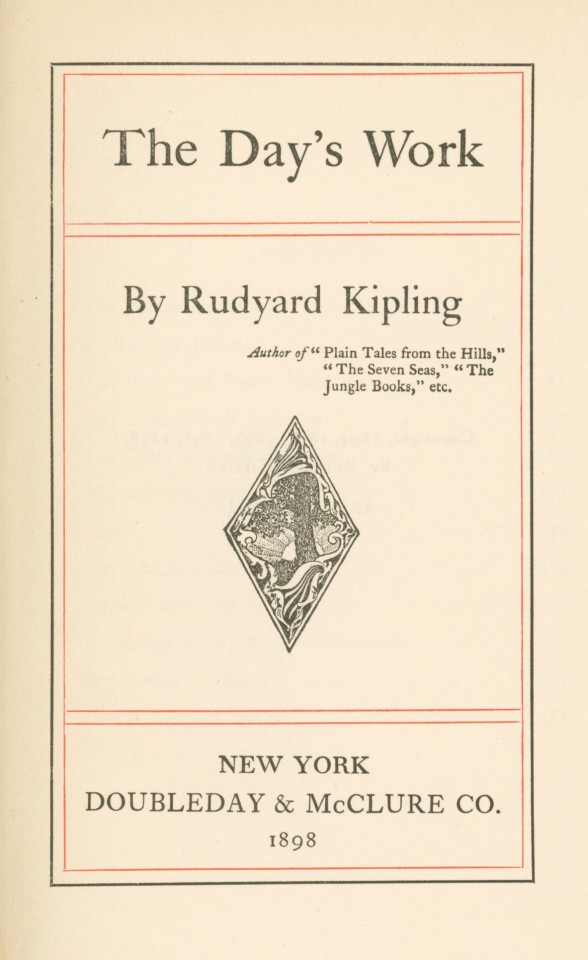


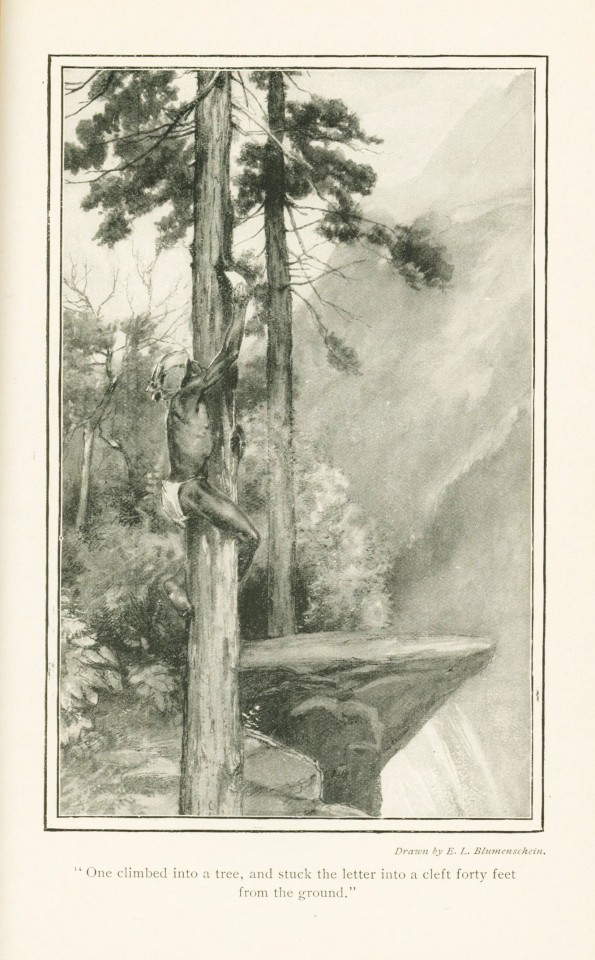

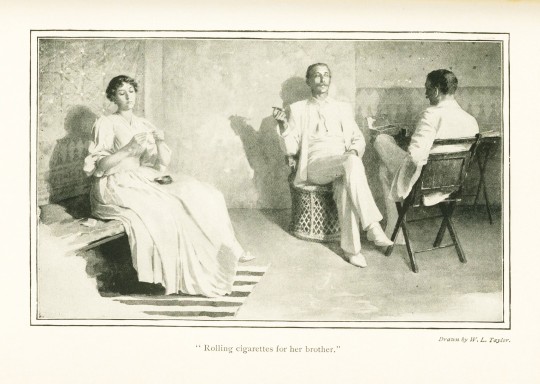

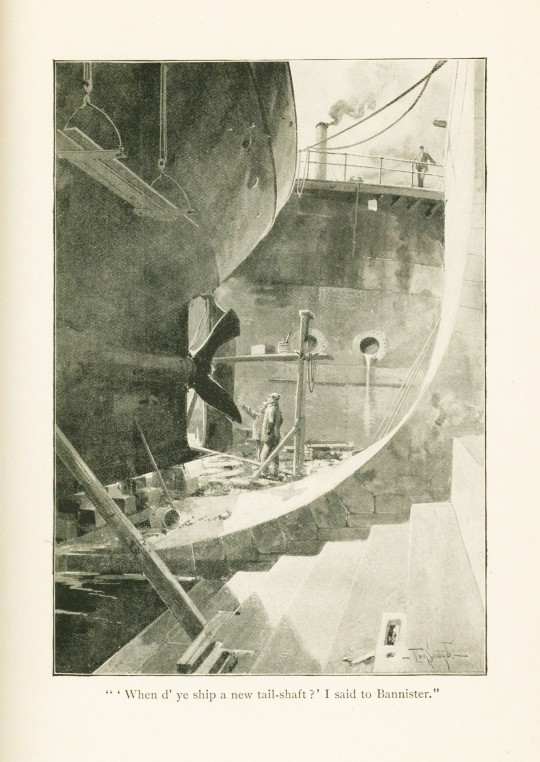
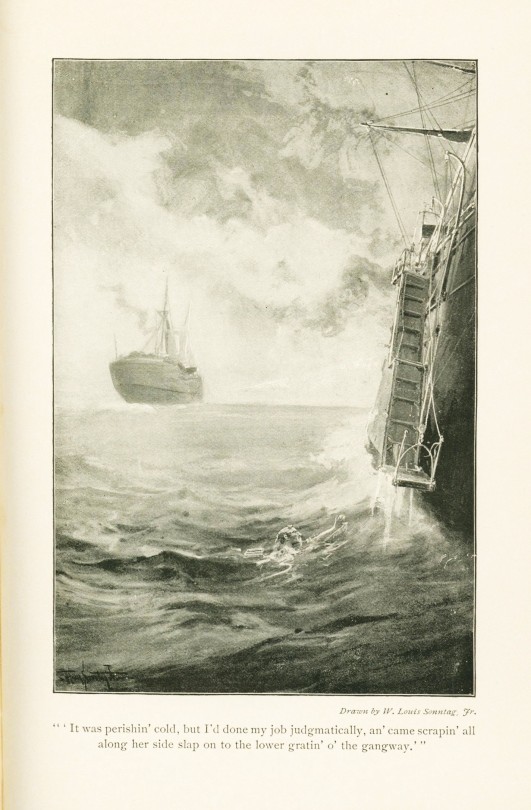
January 8th is the birthday of Frank Nelson Doubleday (1862-1934) who at age ten bought his own printing press to create advertisements and local Brooklyn news circulars and seventy-five years later was known as the co-founder of the largest publisher in the United States. At fifteen years old, Doubleday went to work at Charles Scribner’s Sons, eventually publishing Scribner’s Magazine and heading their subscription book department. After eighteen years, Doubleday left the company and partnered with Samuel Sidney McClure (1857-1949) to open their own publishing venture Doubleday & McClure Company in 1897.
Over the years, Doubleday & McClure Company worked with numerous notable authors and would evolve through a dizzying number of partnerships, acquisitions, and name changes while it grew into an international communications company, eventually settling into a merger with Knopf Publishing Group under Penguin Random House in the early 2000s. In its infancy, still known as Doubleday & McClure, the company found great success with Rudyard Kipling’s (1865-1936) bestseller The Day’s Work.
Published in 1898, The Day’s Work contains thirteen fictional short stories accompanied by illustrations throughout. The stories were written between 1893 and 1896 while Kipling was living in his Bliss Cottage in Vermont and simultaneously working on The Jungle Book. Unlike many of Kipling’s other collections, there are no poems dividing the stories within The Day’s Work. The black and white illustrations within the collection were drawn by four different artists including, William Dodge Stevens (1870-1942), William Louis Sonntag Jr. (1869-1898), Ernest Leonard Blumenschein (1874-1960), and William Ladd Taylor (1854-1926); each leaning into their strengths to support Kipling’s vivid narrative.
Read other Milestone Monday posts here!
– Jenna, Special Collections Graduate Intern
#milestone monday#milestones#frank nelson doubleday#doubleday & mcclure company#charles scribner's sons#samuel sidney mcclure#penguin random house#knopf publishing group#rudyard kipling#the day's work#the jungle book#william dodge stevens#william louis sonntag jr.#ernest leonard blumenschein#william ladd taylor
21 notes
·
View notes
Text

A Farewell To Arms (1929)
Ernest Hemingway
Charles Scribner's Sons
1 note
·
View note
Text
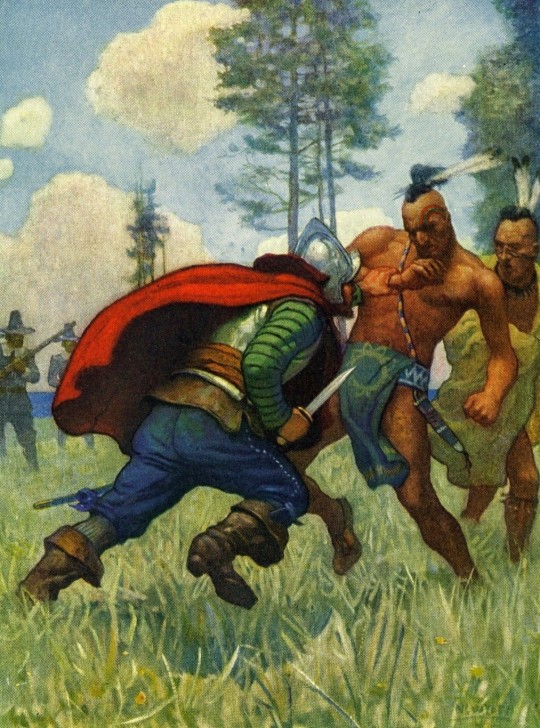
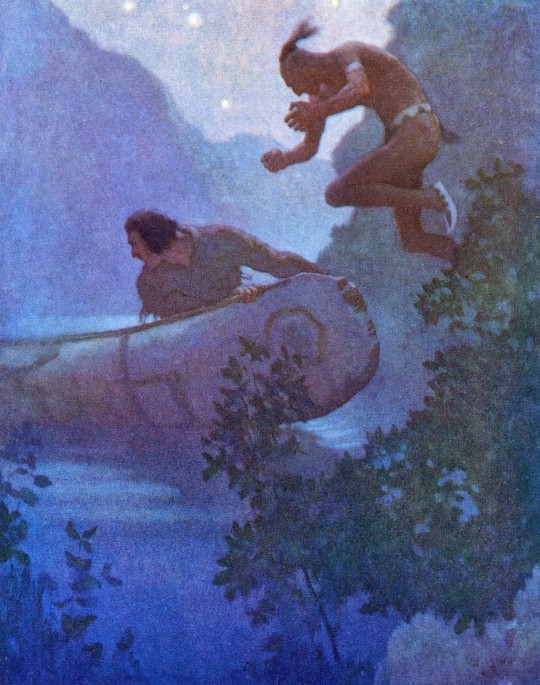
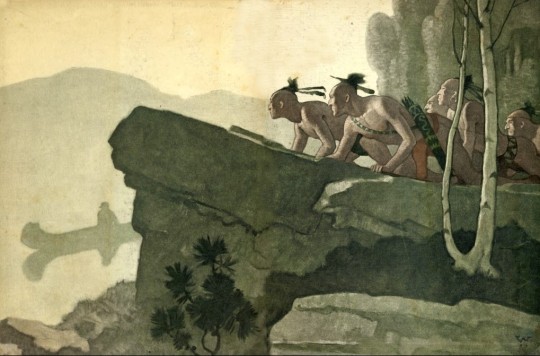
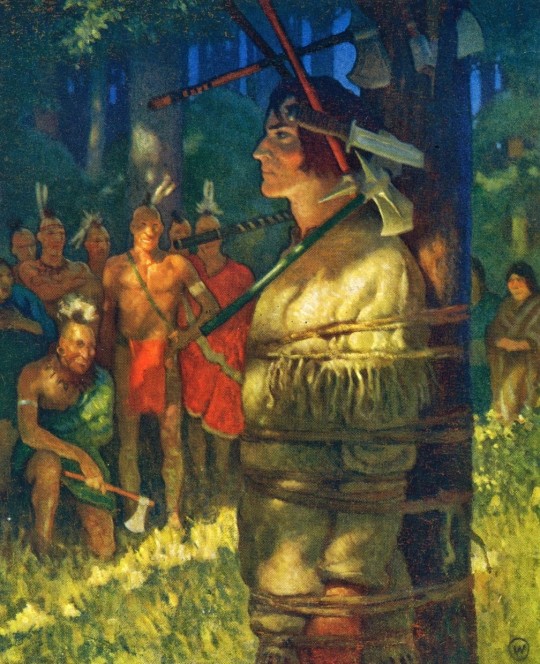
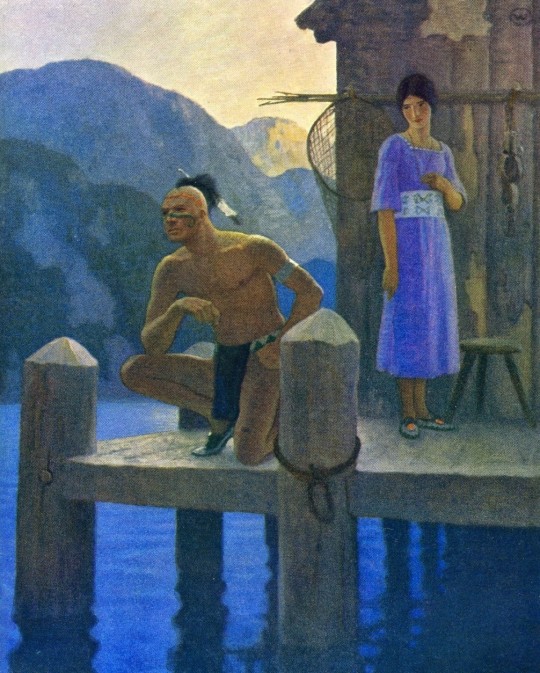
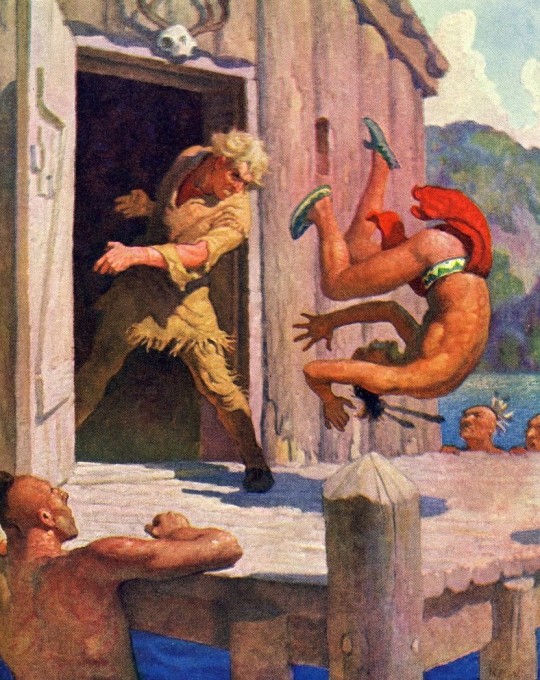
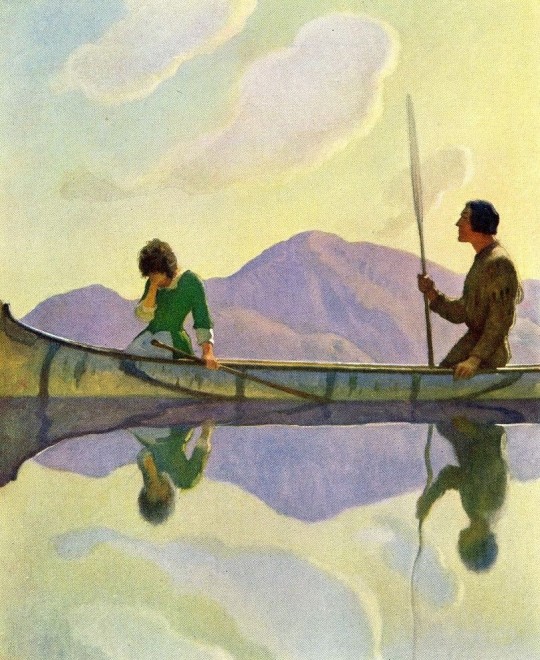
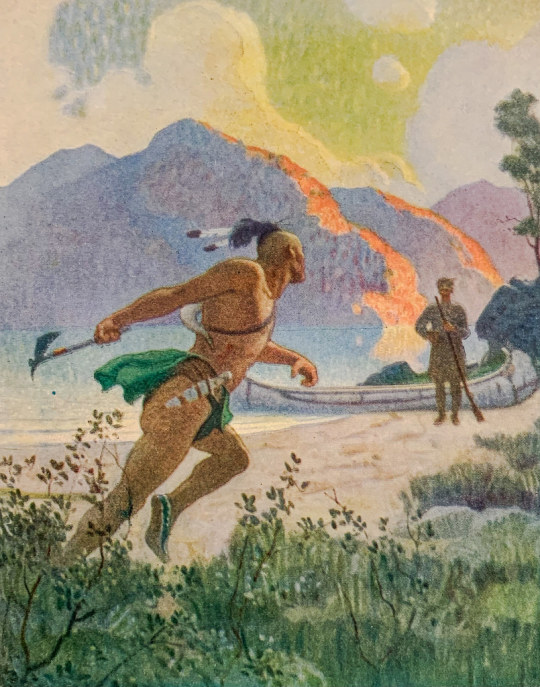
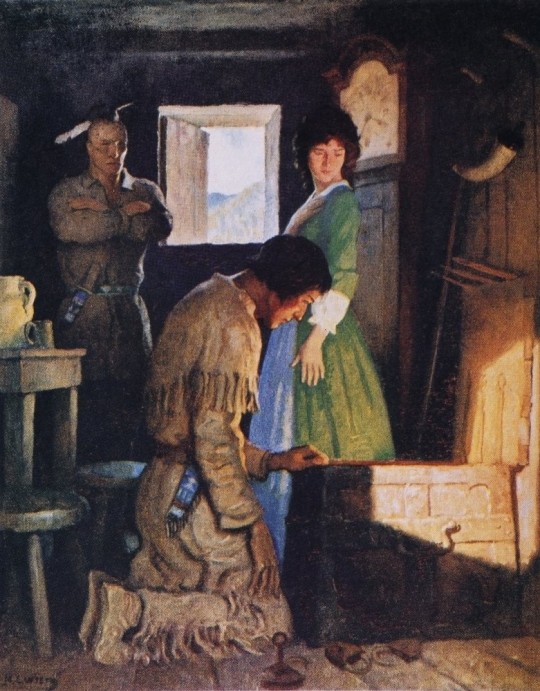
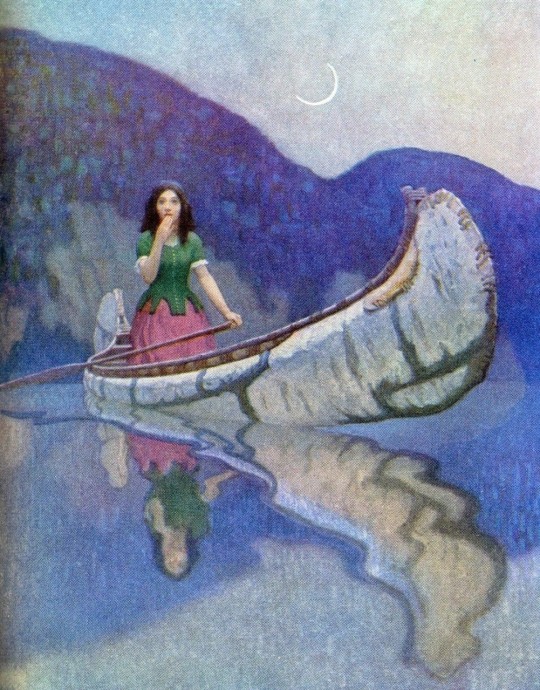
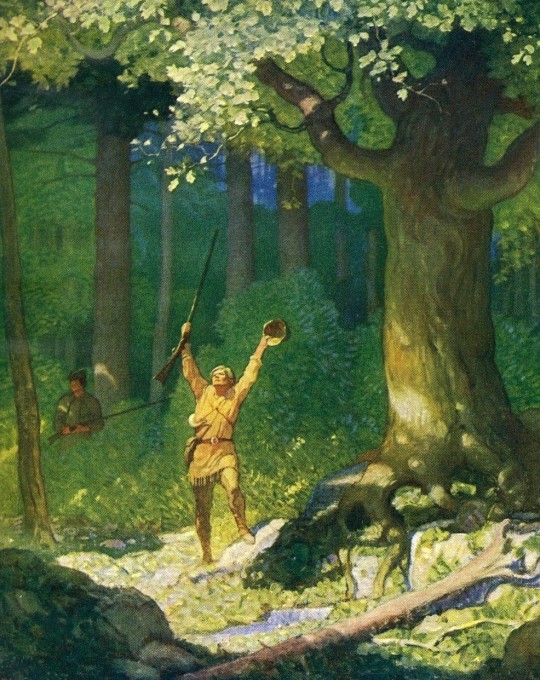
The Deerslayer - art by N. C. Wyeth (1925)
#n. c. wyeth#the deerslayer#james fenimore cooper#book illustrations#adventure novels#leatherstocking tales#nathaniel bumppo#hawkeye#charles scribner's sons publisher#1920s#1925
122 notes
·
View notes
Text

"Then the king ... ran towards Sir Mordred, crying, 'Traitor, now is thy death day come.'" Illustration by N.C. Wyeth for The Boy's King Arthur: Sir Thomas Malory's History of King Arthur and His Knights of the Round Table, Edited for Boys by Sidney Lanier (New York, Charles Scribner's Sons, 1922).
#art#art history#N.C. Wyeth#illustration#King Arthur#Mordred#Knights of the Round Table#Battle of Camlann#Arthuriana#Arthurian legend#American art#20th century art
316 notes
·
View notes
Text

"'Mignon' amongst the peonies to which I always compared her (snapshot taken by myself)"
Photograph of Princess Maria of Romania (later Queen Maria of Yugoslavia) by her mother, Queen Marie of Romania, early 1900s.
Marie, Queen of Romania, The Story of My Life (New York: Charles Scribner's Sons, 1934)
93 notes
·
View notes
Text

“The Pledge” N.C. Wyeth 1921 Illustration for The Scottish Chiefs by Jane Porter, edition published in New York by Charles Scribner's Sons.
163 notes
·
View notes
Text
From The Library of Anne Rice (Part 1)
A list of books owned by Anne Rice including annotation information taken from auction listings at Bonham's, October 2024. Will continue in Part 2.

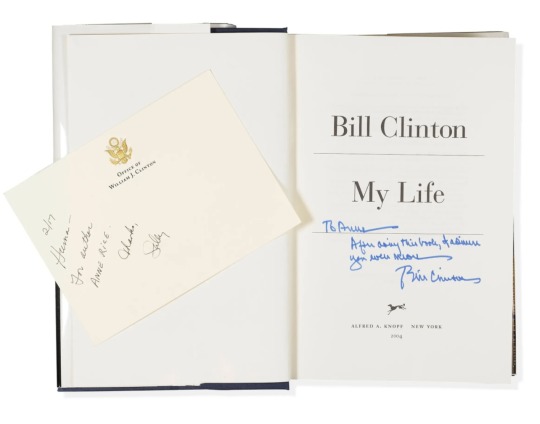
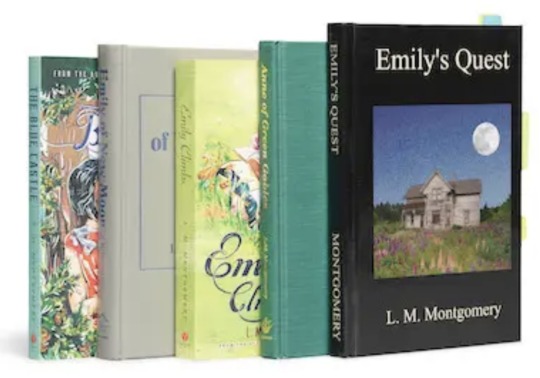

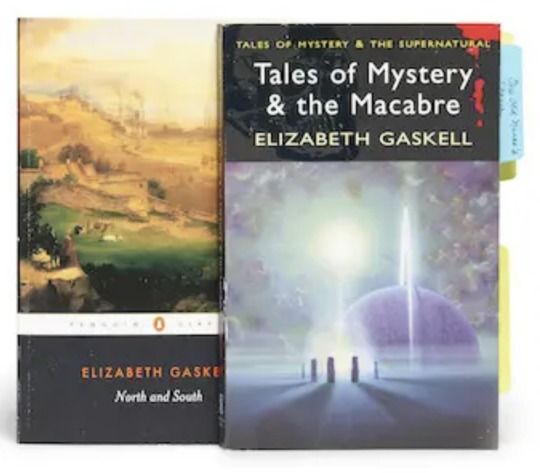

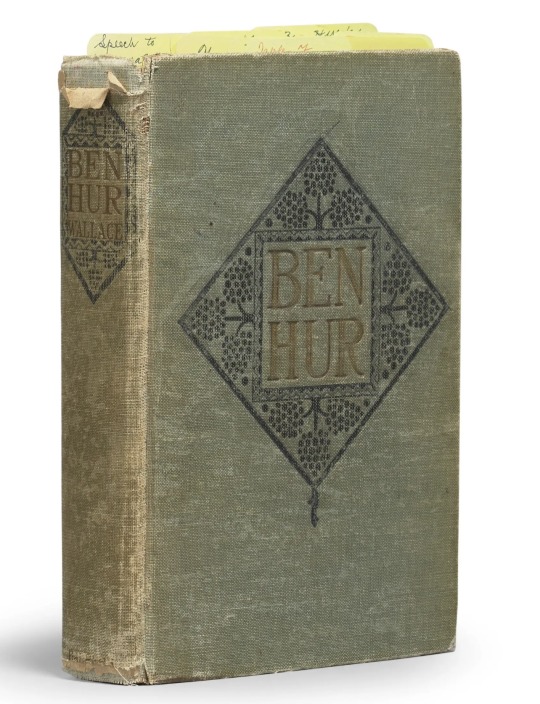
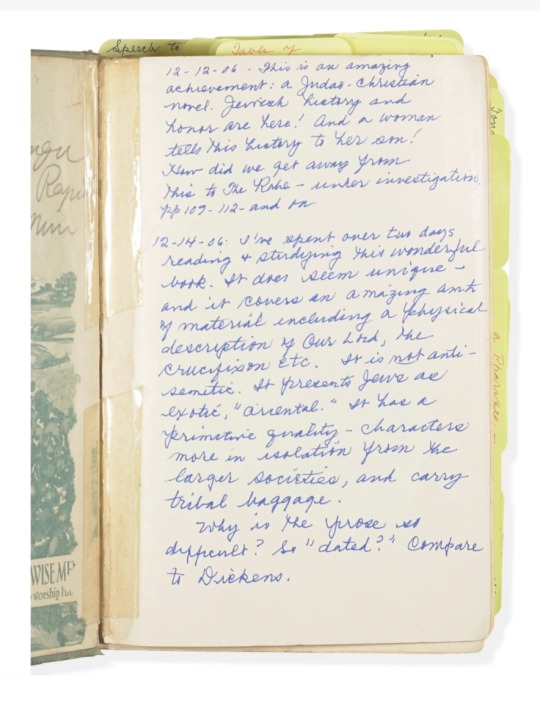
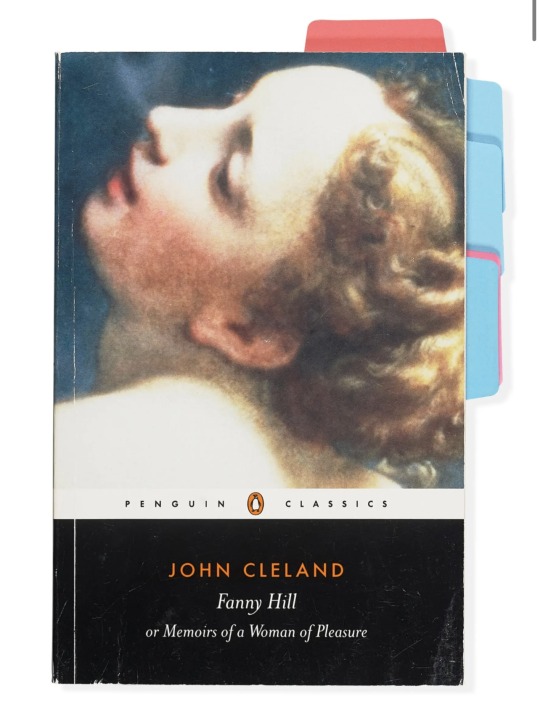
Frazer, James G. The Golden Bough: A Study in Magic and Religion (abridged edition).New York: MacMillan Publishing Co., 1963. She writes on the flyleaf in June of 2012: "When I bought this book I don't know. I know I read it or a copy of it in the 1980s when writing The Vampire Lestat. It is essential to me." On the jacket spine she has added "Sacred!"
Frazer, James G. The Golden Bough: A Study in Magic and Religion. 1981. Marked on the cover, "Gift to Stan from Anne 1985 / Save Always, AR," and internally reads in Stan's handwriting: "A gift to me from Anne because I've never read it."
Gaskell, Elizabeth. Tales of Mystery & the Macabre. Wordsworth edition, 2007. bears Rice's ownership signature to title page ("Anne Rice / May 29, 2012 / The Desert") and is tabbed and annotated throughout.
Gaskell, Elizabeth. North and South. Penguin Books, 2000. bears her ownership signature on the title page.
Hemingway, Ernest. For Whom the Bell Tolls. New York: Charles Scribner's Son, 1940. Original beige cloth stamped cover and spine, in facsimile dust jacket. First edition with the Scribner's "A" on the copyright page. With Post-it note to front pastedown indicating that the book was a gift "From Becket and Christina / Christmas / 2012."
King, B. B. & David Ritz. Blues All Around Me: The Autobiography of B.B. King. New York: Avon Books, 1996. First edition, inscribed to "To Anne / All the best to you / B.B. King / 10-18-96."
Montgomery, L.M. Anne of Green Gables. Cutchogue, NY: Buccaneer Books, 1976. Anne Rice ownership signature dated February 7, 2015, Palm Desert. Annotated on front pastedown; "It's immediately a pleasure, and making me want to write."
Montgomery, L.M. Emily's Quest. Oxford City Press, 2009. Anne Rice ownership signature dated February 21, 2015; annotated and tabbed.
Montgomery, L.M. Emily Climbs. Sourcebooks, 2014. Anne Rice ownership signature dated February 12, 2015.
Montgomery, L.M. Emily of New Moon. Ameron House, c.2015. Anne Rice ownership signature dated February 6, 2015, inscribed: "Reading the paperback and loving it so much I had to have a hardcover."
Montgomery, L.M. The Blue Castle. Sourcebooks, 2011. Anne Rice ownership signature dated May 12, 2015 to title page.
Puzo, Mario. The Godfather. New York: Putnam, 1969. Book club edition. On May 26 and 27, 2013, she writes, "Badly need this, Studying in detail" and on page 74 she writes, "Note how easily it flows." She has great praise for the nimbleness of the novel's p.o.v. and is often asking herself "how can I learn from this?" On p 225 she writes, "This is a most impressive piece of work and is masterly. Again I marvel at vocabulary, tone, and placement—organization of the book. I fight OCD as I write, I've come to see that, and this helps me to see what this novel accomplishes. Presenting the Don as a 'great' man, a 'genius,' without apology is a conscious approach that is so powerful."
Puzo, Mario. The Godfather. Another copy, later edition, lacking jacket. With Anne Rice's ownership signature.
Puzo, Mario. The Godfather Papers and Other Confessions. London; William Heinneman, 1972.
Puzo, Mario. The Fortunate Pilgrim. New York: Random House, 1997. Anne Rice ownership signature.
Wallace, Lew. Ben-Hur: A Tale of the Christ. New York and London: Harper & Brothers, 1908. Anne Rice re-read this copy of Ben-Hur in 2006, a used copy she picked up somewhere, leaving detailed marginalia throughout and summing up her thoughts on the first flyleaf: "12-12-06: This is an amazing achievement: a Judeo-Christian novel. Jewish history and honor are here! And a woman tells this history to her son! How did we get away from this to The Robe ... 12-15-06: I've spent over two days reading & studying this wonderful book. It does seem unique—and it covers an amazing amt of material including a physical description of Our Lord, the crucifixion, etc. It is not anti-semitic. It presents Jews as exotic, 'oriental.' It has a primitive quality ... why is the prose so difficult? so 'dated'? Compare to Dickens." Rice's notes in the margin often compare the novel to (presumably the 1959 version of) the film, finding the novel superior in every way, and commenting more than once on its structural similarities to Dickens: "the whole spectacle and the co-incidence" (p 166).
Cleland, John. 1709-1789. Fanny Hill or Memoirs of a Woman of Pleasure. New York: Penguin Books, 1985. Annotated and with ownership signature to the title page: "Anne Rice / January 2014 / Palm Desert." Rice underscores Cleland's descriptions of bodies and physical acts, and in particular, wonders about the novel's p.o.v.: on p 108 she writes in the margin, "Is this a man's view? A gay man? An author who is male and female?"
Clinton, Bill. Born 1946. My Life. New York: Alfred Knopf, 2004. Jacket spine with label "From the library of Anne Rice" laid down to tail. First edition, inscribed on the title page, "To Anne—After doing this book, I admire you even more—Bill Clinton." with: a note on the Office of William J. Clinton letterhead: "2/17 —Huma—For author ANNE RICE.—Thanks, Sally." When Clinton published his memoir in 2024, Rice was one of the VIPs to receive a presentation copy, in which he expresses his admiration for her work after having written a book of his own.
Bellman, Henry. 1882-1945. Kings Row. New York: Simon and Schuster, 1943. Annotated and with ownership signature to front free endpaper: "Anne Rice / June 27, 2013 / Palm Desert." Rice has carefully read and annotated this copy, complementing the writing (particularly when Bellamann writes about Father Donovan) and adds a long note on the rear pastedown: "Pages & pages of this book are about the mind—about how the mind learns, expands, grows, experiences." Sometimes her comments are in conversation with the text, as when, on p 153, she underlines the town of Auvergne and writes "Auvergne, what a coincidence! As I plan a trip there and write about Lestat!"
Dickens, Charles. David Copperfield. New York: Penguin Classics, 2014. With ownership signature of Anne Rice dated June 11, 2018, tabbed and annotated throughout. On the preliminary leaf of Copperfield, Rice writes, "Again with my beloved David, and my beloved Dickens. I have just read Claire Tomalink 'The Invisible Woman' and her later bio of Dickens. I'm writing my new novel in my head."
Dickens, Charles. Great Expectations. New York: Penguin Classics, 2008. Signed and dated June 15, 2018, tabbed and annotated throughout.
Rawlings, Marjorie Kinnen. South Moon Under. New York, London: Charles Scribner's Sons, 1933 (undated later facsimile edition).
Mitchell, Margaret, Gone With the Wind. New York: [Simon and Schuster], 2011. Rice reread this copy in March of 2015, tabbing dozens of pages and commenting in the margins.
Tolstoy, Leo. War and Peace. New York: Alfred Knopf, 2007. The first date on this copy of War and Peace is June 30, 2010, and Rice writes: "The Desert / Being reborn in Tolstoy, studying at his feet—Searching for the Christ who is bigger than religion." In a different ink, Rice adds at the top of the same page, "Revisiting 7-16-17—Having seen much of the new BBC series with Lily James as Natasha." Rice has tabbed the pages throughout this volume and made extensive notes on character development and theme. On the rear flyleaf, she adds, "'Life is everything...' p 10064— use for L" as well as "The guiltlessness of suffering (do we make ourselves suffer to be guiltless)?"
Tolstoy, Leo. Anna Karinina. Translated by Rosamund Bartlett. Oxford: Oxford University Press, 2014. Signed and annotated February 19, 2015. Heavily tabbed, especially in the center part of the novel, and noted on the front flyleaf: "Reading chunks of the story of Levin & Kitty / So beautiful and smooth—"
30 notes
·
View notes
Text

May Swenson, Iconographs. Poems, Charles Scribner's Sons, New York, NY, 1970 [© May Swenson]





«I call the poems 'Iconographs' with such dictionary derivations in mind as these: icon "a symbol hardly distinguished from the object symbolized" icono- from the Greek eikonos meaning "image" or "likeness" graph "diagram" or "system of connections or interrelations" -graph from the Greek graphe meaning "carve"…" indicating the instrument as well as the written product of the instrument" Also, this comment on 'The Art of the Middle Ages' (Columbia Encyclopedia, 3rd Edition) helped me choose the title: "…(It) was governed by a kind of sacred mathematics, in which position, grouping, symmetry, and number were of extraordinary importance and were themselves an integral part of the iconography. From earliest times it has likewise been a symbolic code, showing men one thing and inviting them to see in it the figure of another…"» ― May Swenson, A Note About 'Iconographs', p. 86
«I have not meant the poems to depend upon, or depend from, their shapes or their frames; these were thought of only after the whole language structure and behavior was complete in each instance. What the poems say or show, their way of doing it with language, is the main thing. Poetry is made with words of a language. And we say, "But, of course." It is just this "matter of course" that poetry holds to the nostrils, sticks into the ears, puts on the tongue, flashes into the eyes of anyone who comes to meet it. It is done with words; with their combination—sometimes with their unstringing. If so, it is in order to make the mind re-member (by dismemberment) the elements, the smallest particles, ventricles, radicals, down to, or into, the Grain—the buried grain of language on which depends the transfer and expansion of consciousness—of Sense. And no grain, of sense, without sensation. To sense then becomes to make sense.» ― May Swenson, A Note About 'Iconographs', p. 87
#graphic design#art#poetry#concrete poetry#visual poetry#book#cover#book cover#may swenson#charles scribner's sons#1970s
40 notes
·
View notes
Text
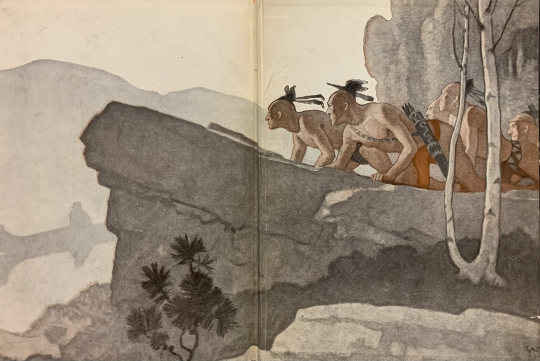
Endpapers by N. C. Wyeth for “The Deerslayer” by James Fenimore Cooper. New York: Charles Scribner’s Sons, 1929
172 notes
·
View notes
Text

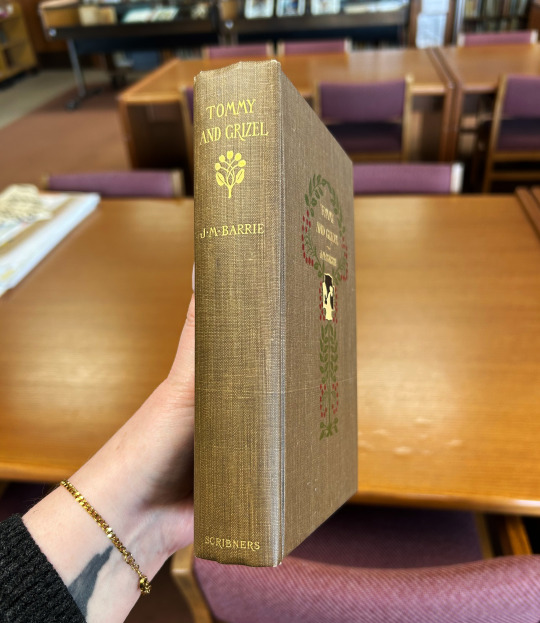



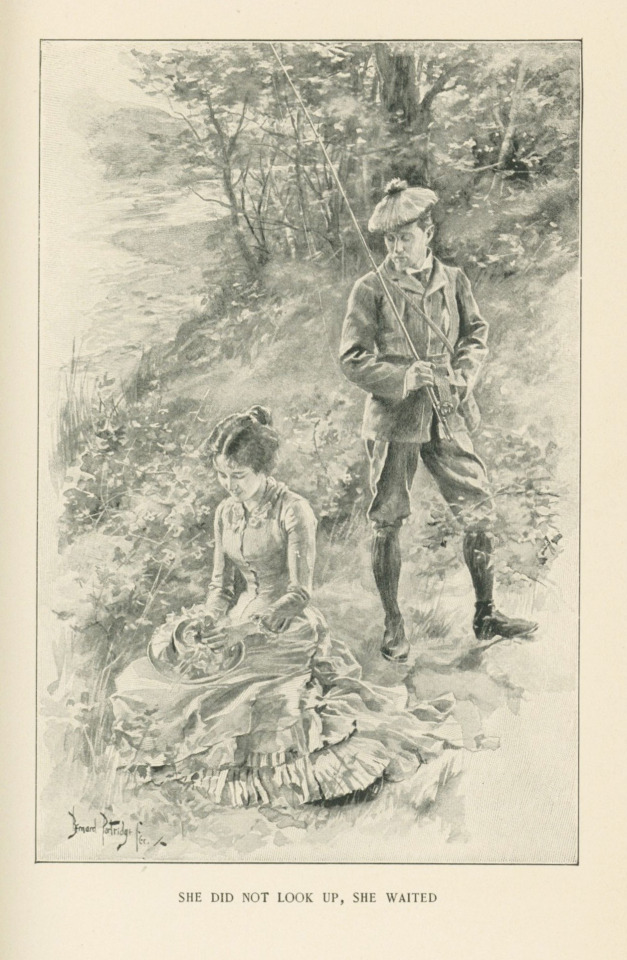

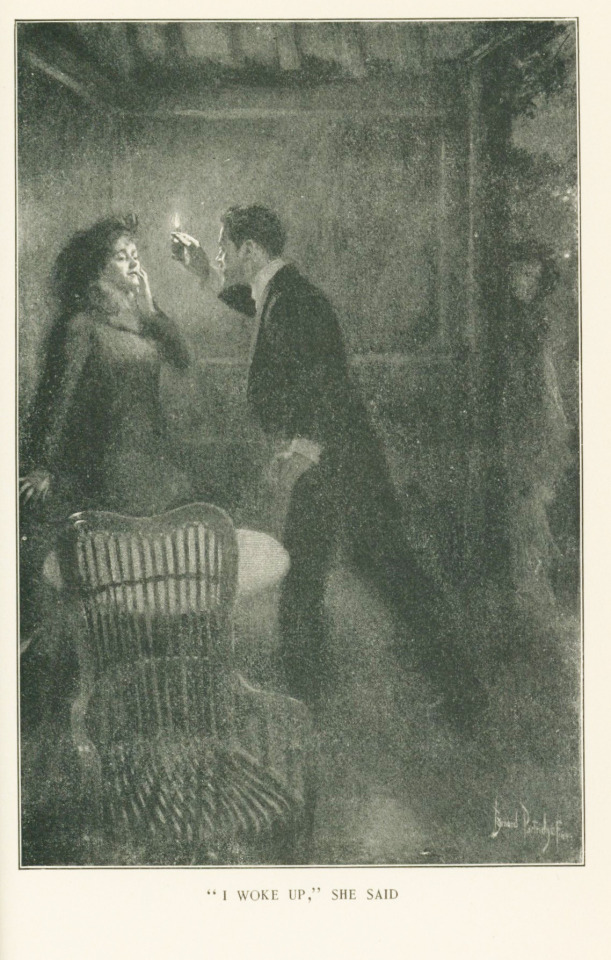

Publishers' Binding Thursday
This week's publishers' binding is Tommy and Grizel by Scottish novelist and playwright J.M. Barrie (1860-1937). This is the first American edition of Tommy and Grizel, which was published in 1900 by Charles Scribner's Sons. The illustrator is not named in the book but we found out that the illustrations are by English cartoonist and illustrator Bernard Partridge. Some of the illustrations are quite strange, featuring ghostly figures and strange captions like "'I woke up,' she said."
The cover was designed and is signed by renowned publishers' binding designed by Margaret Armstrong—her signature MA stamp can be seen in the bottom left of the design. The design includes leafy vines with berries on them (perhaps a nod to Barrie's name?), a shield with two 3-leaved clovers in black and gold, and the title and author's name. On the spine the title and author's name are again stamped in gold accompanied by a floral decoration. The cover is a warm brown book cloth.
View more Publishers' Binding Thursday posts.
-- Alice, Special Collections Department Manager
#Publishers' Binding Thursday#publishers' bindings#Margaret Armstrong#J.M. Barrie#James M. Barrie#Tommy and Grizel#Bernard Partridge#Charles Scribner's Sons
19 notes
·
View notes
Text
Round One, Match CXXXV


Howl's Moving Castle (Diana Wynne Jones), Greenwillow Books 2008. Cover by John Rocco.
All The Sad Young Men (F. Scott Fitzgerald), Charles Scribner's Sons 1926. Cover by Cleo Damianakes.
18 notes
·
View notes
Text

N.C. Wyeth (American, 1882–1945) • Cover of The Boy's King Arthur by Thomas Mallory • 1922 • Charles Scribner's Sons, publisher
#art#artwork#illustration#illustrator#n. c. wyeth#american artist#children's literature#arthurian literature#american illustrator#book illustration#sassafras & moonshine blog#illustration blogs on tumblr
42 notes
·
View notes
Note
hi! New here. I have a question! I heard Hamilton had violet-blue mixed eyes. Do you think he had Alexandria's genesis? I mean, it's the closest to what I think it could be. Since violet eyes aren't naturally accusing and are generally the result of a mutation.
This has actually been a theory of mine for a while now! As always, we may never know for certain. But Alexandria Genesis was not discovered until around the year 2013, [x] thus of course, the people of the colonial days would not know of any proper terminology for this rare sort of diagnosis; but there are many accounts of Hamilton that would actually describe the symptoms. Fisher Ames account of Hamilton's eye color in the New York Mirror was recorded as;
The same writer remarks that General Hamilton’s eyes were grey. This is a mistake. They were of a deep azure, eminently beautiful, without the slightest trace of hardness or severity, and beamed with higher expressions of intelligence and discernment than any others I saw oscillate in the “human face divine.”
New York Mirror: A Weekly Gazette of Literature and the Fine Arts. United States, G. P. Morris, 1825.
Even though Hamilton's own grandson, Allan McLane, would go on to describe Hamilton's eyes as having taken on a purple shade—His grandfather had died years before his birth, so it is far from a first hand account, yet decently worth noting in case he may have heard it from relatives or friends of Hamilton;
His eyes were a deep blue—almost violet—and he undoubtedly presented the physical appearance of his Scotch father rather than his French mother: His eyes were deep set, his nose long, and of the Roman type, and he had a good chin, the jaw being strong; the mouth firm and moderately large.
Hamilton, Allan McLane. The Intimate Life of Alexander Hamilton: Based Chiefly Upon Original Family Letters and Other Documents, Many of which Have Never Been Published. United States, C. Scribner's sons, 1910.
To go further, other symptoms of Alexandria Genesis were noted in the link above as; “Those who have this mutation will never grow any facial, body, pubic, or anal hair (not including hair on their head, on their ears, noses, eyebrows and eyelashes). Women also do not menstruate, but are fertile”
There are no accounts of Hamilton having any noticable facial hair at all, rather the opposite in fact, where he is often described as having a young, or even feminine appearance. Additionally, if you look closely at many portraits of Hamilton throughout his lifetime, you will notice there are no signs of any facial hair around his portrayed face;



In order; portrait of Alexander Hamilton, by Charles Peale (ca. 1780), Alexander Hamilton portrait, by John Trumbull (ca. 1792), portrait of Alexander Hamilton, by Ezra Ames (ca. 1802)
#amrev#american history#american revolution#alexander hamilton#historical alexander hamilton#history#queries#sincerely anonymous#cicero's history lessons
49 notes
·
View notes
